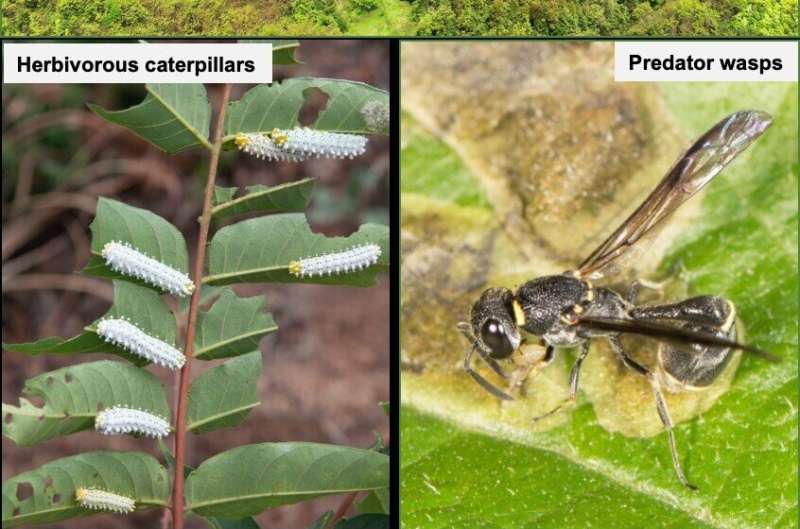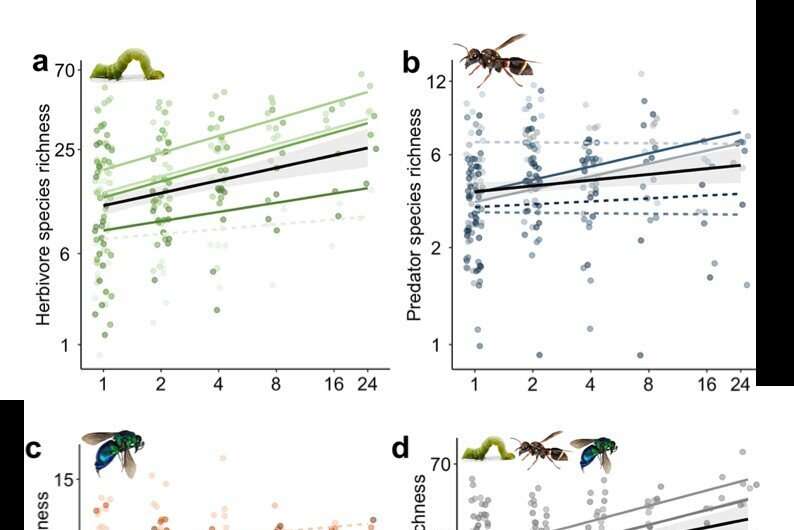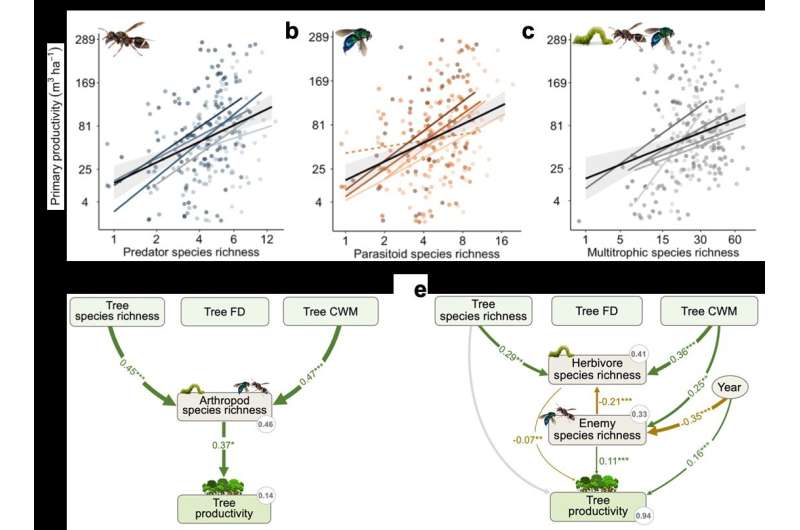This article has been reviewed according to Science X's editorial process and policies. Editors have highlighted the following attributes while ensuring the content's credibility:
fact-checked
peer-reviewed publication
trusted source
proofread
Arthropods in high-diversity forests found to contribute to improved productivity

An international team of researchers led by Prof. Ma Keping from the Institute of Botany of the Chinese Academy of Sciences (IBCAS) has shown that forests with higher tree species richness tend to have greater arthropod diversity.
The researchers showed that higher tree diversity promotes productivity through the suppression of herbivores by enemy arthropods.
These findings, published recently in Nature Ecology & Evolution, underscore the importance of arthropod diversity as a mediator of the effects of tree diversity on forest productivity.
Managing forests for increased productivity will require both increased tree diversity and multitrophic diversity, according to the researchers.
Forests are home to 80% of terrestrial plant and animal diversity, making them a critical component of global biodiversity conservation. However, forest biodiversity is under serious threat from anthropogenic disturbance and climate change. Species-rich groups such as arthropods are declining dramatically due to the degradation of forests and loss of plant diversity.
Most studies of biodiversity–ecosystem functioning (BEF) relationships have focused solely on plant diversity, neglecting the impact of the diversity of other trophic groups. As a result, it remains unclear how the diversity of herbivores and their enemies affects ecosystem functioning. Given the importance of forests in providing essential ecosystem services and global biodiversity, it is vital to understand these relationships and take action to protect them.

Using five years of data on aboveground herbivorous, predatory, and parasitoid arthropods, together with tree growth data from a large-scale forest biodiversity experiment in southeastern China (BEF-China), the researchers showed that the effects of increased tree species richness were consistently positive for species richness and abundance of herbivores, predators, and parasitoids.
This finding is consistent with a previous study from another large grassland biodiversity experiment (the Jena Experiment) and again shows that conserving plant diversity is important to conserving arthropod diversity.
However, in contrast to the bottom-up control of arthropod diversity by plant diversity in the central European grassland study, this new study in the species-rich forests of southeastern China shows that higher tree diversity can enhance the top-down control of herbivores by their enemies, thereby contributing to increased productivity.
"This study emphasizes that arthropod diversity plays an important role in mediating the effects of tree diversity on primary productivity," said Dr. Li Yi, a postdoc researcher at IBCAS and first author of the study.
A previous study conducted at the same sites showed that increasing plant diversity can promote forest productivity directly. The new study shows that increasing plant diversity can also indirectly increase forest productivity by promoting arthropod diversity and trophic interactions.
"It underscores the critical role of conservation efforts aimed at maintaining forest biodiversity," said Prof. Liu Xiaojuan, senior author and leader of the BEF-China management group.

To draw more reliable conclusions, the researchers conducted multi-year sampling. According to Prof. Ma, chairman of the BEF-China platform, this approach takes into account the possibility that different arthropod groups may be affected inconsistently from year to year.
"It also highlights the value of the BEF-China platform, not only as the world's largest experiment on forest biodiversity and ecosystem functioning, but also as an open and international platform for long-term ecological research," he said.
"The BEF-China platform provides valuable opportunities for international research teams and young researchers in different directions," said Prof. Zhu Chaodong, an author from the Institute of Zoology of CAS.
Overall, while several recent studies have documented declines in terrestrial arthropod biodiversity, few have examined the consequences for ecosystems.
"This work fills that gap by demonstrating the important role of arthropod diversity in BEF relationships," said Prof. Bernhard Schmid, an author from the University of Zurich.
In summary, these findings are of great importance in guiding the public to understand the conservation of forest biodiversity, plants, animals, and ultimately their associated microbes.
More information: Yi Li et al, Multitrophic arthropod diversity mediates tree diversity effects on primary productivity, Nature Ecology & Evolution (2023). DOI: 10.1038/s41559-023-02049-1. www.nature.com/articles/s41559-023-02049-1
Journal information: Nature Ecology & Evolution
Provided by Chinese Academy of Sciences




















